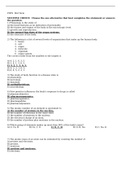PHYS Mid Term
MULTIPLE CHOICE. Choose the one alternative that best completes the statement or answers the question.
1) Physiology is the study of
A) the facial features as an indication of personality.
B) the tissues and organs of the body at the microscopic level.
C) growth and reproduction.
D) the normal functions of the organ systems.
E) the structure of the body.
2) The following is a list of several levels of organization that make up the human body.
1. tissue
2. cell
3. organ
4. molecule
5. organism
6. organ system
The correct order from the smallest to the largest is
A) 4, 2, 1, 6, 3, 5.
B) 2, 4, 1, 3, 6, 5.
C) 4, 2, 1, 3, 6, 5.
D) 4, 2, 3, 1, 6, 5.
E) 6, 4, 5, 2, 3, 1.
3) The study of body function in a disease state is
A) physiology.
B) necrology.
C) histology.
D) pathophysiology.
E) microbiology.
4) How genetics influences the body’s response to drugs is called
A) pharmacokinetics.
B) pharmacogenomics.
C) pharmacogenetics.
D) pharmageddon.
E) pharmacodynamics.
5) The atomic number of an element is equivalent to
A) the number of protons in the nucleus.
B) the number of electrons in the outer shell.
C) the number of neutrons in the nucleus.
D) the electrical charge of an atom.
E) the number of protons plus neutrons in the nucleus.
6) Which group of elements makes up more than 90% of the body's mass?
A) O, Ca, HB) Ca, C, OC) O, C, HD) O, H, NaE) C, Na, K
7) The atomic mass of an atom can be estimated by counting the number of
A) protons and electrons.
B) protons.
C) neutrons. D) protons and neutrons.
E) electrons. 8) Each amino acid differs from others in the
A) size of the amino group.
B) number of central carbon atoms.
C) number of carboxyl groups.
D) chemical structure of the R group.
E) number of peptide bonds in the molecule.
9) Nucleic acids are polymers of units called
A) nucleotides.
B) fatty acids.
C) bases.
D) ribose.
E) amino acids.
10) A component of an important buffer in the human body is
A) H2O.B) NaCl. C) HCO3-.D) HCl. E) H+.
11) The basic structural and functional unit of the human body is
A) tissue.
B) the cell.
C) protein.
D) the organ system.
E) the organ.
12) Cell membranes are said to be
A) actively permeable.
B) impermeable.
C) freely permeable.
D) selectively permeable.
E) none of the above
13) Most of the ATP required to power cellular operations is produced in the
A) endoplasmic reticulum.
B) Golgi apparatus.
C) mitochondria.
D) ribosomes.
E) nucleus.
14) Glands that secrete hormones directly into the blood are
A) endocrine glands.
B) mixed glands.
C) unicellular glands.
D) exocrine glands.
E) none of the above
15) According to the second law of thermodynamics,
A) the total amount of energy in the universe never changes.
B) the amount of entropy increases during natural processes.
C) energy can be converted, but not be created nor destroyed.
D) entropy decreases in living systems as a result of cellular processes.
16) When a chemical reaction is in equilibrium
A) there are equivalent amounts of reactants and products.
B) the reaction has stopped.
C) there is no net change in the amount of reactants or products.
D) the reaction is proceeding at its maximum rate.
17) A competitive inhibitor binds to
A) the surrounding tissue.




